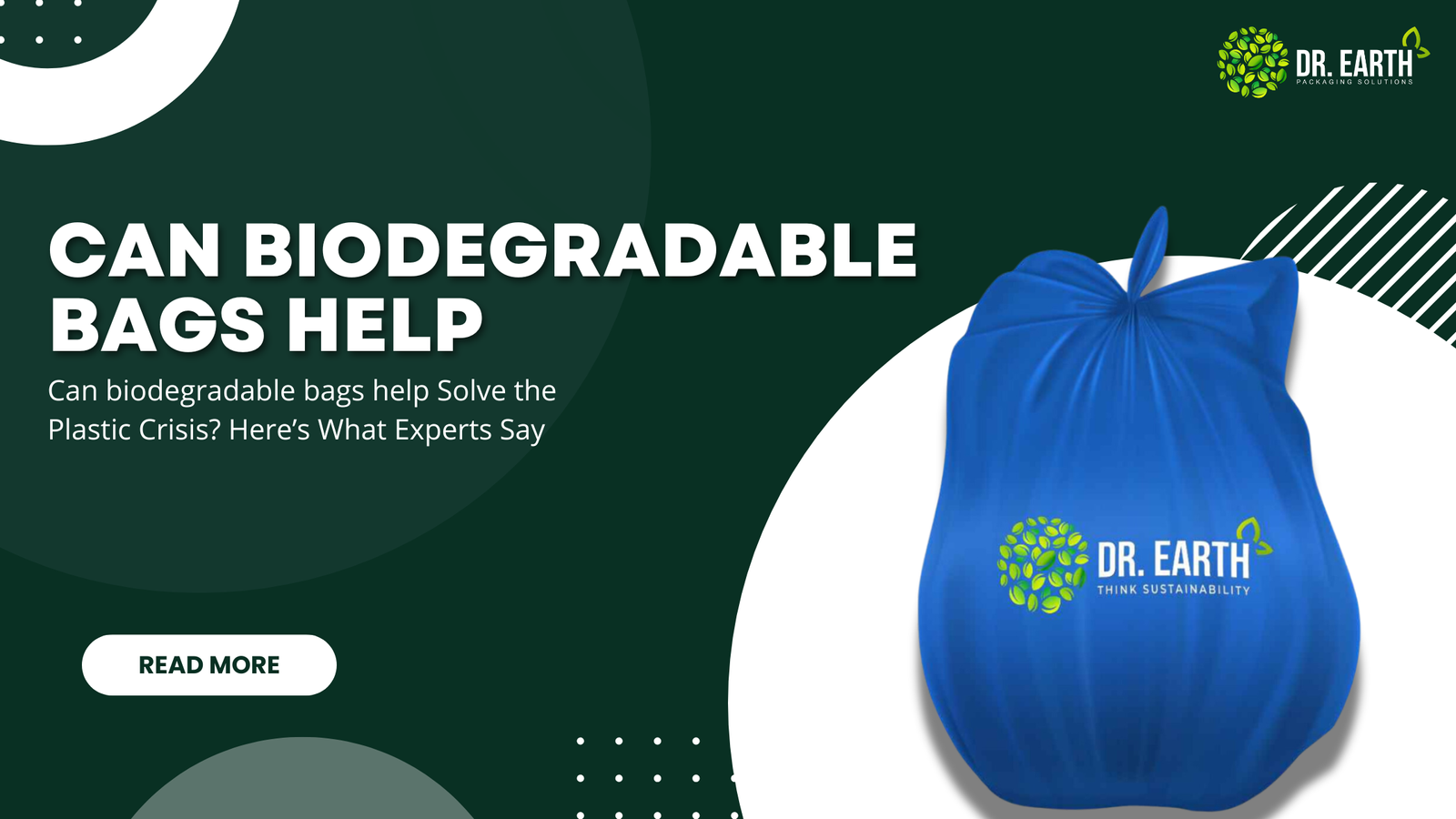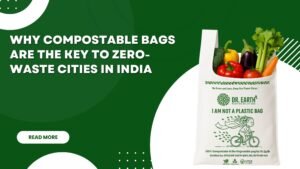
The plastic crisis has reached very alarming proportions because millions of tons of plastic go into our oceans, hurting the wildlife, and eventually will find its way into our food chain. In response to this crisis, biodegradable bags have been designed and marketed to be an eco-friendly alternative to traditional plastic. Will these bags really help solve the plastic crisis? Experts in various fields contend that they become the solution many aspire for if taken on collectively by all.
Biodegradable bags are made from natural products, and companies like Dr. Earth are manufacturing bags that do not leave any hazardous residues during the decomposition process. The article will continue to explain how biodegradable bags work, the science that explains their effectiveness, and what experts say about their ability to end the plastic pollution crisis.
The Plastic Crisis: Understanding the Scope
Every year, around 300 million tons of plastic have been manufactured, mostly for landfills and oceans, among other sites. Regular plastic bags remain intact for hundreds of years and break down slowly, affecting both soil and water by poisoning thousands of animals.
Key facts about the plastic crisis:
- Plastic pollution constitutes approximately 80 percent of the marine debris.
- An estimated 1 million marine animals die each year due to either plastic ingestion or entanglement.
- Plastic will triple by 2040, with no major action in place.
Against this grim scenario, experts are insisting that there is a crying need for sustainable solutions like biodegradable bags designed to decompose without harming the environment.
How Do Biodegradable Bags Work?
Biodegradable bags are made of natural, renewable resources including corn, potato starch, and other plant-based products. Unlike petrochemical-derived plastics, these materials will degrade much more easily in the composting environment, which would transform into natural substances such as carbon dioxide, water, and biomass in weeks or months.
Key Features of Biodegradable Bags:
- Quick Summary: Biodegradable bags break down entirely under favorable conditions within 3-6 months, whereas plastics take hundreds of years to decompose.
- No Toxic Residues: The good-quality biodegradable bags, such as the Dr. Earth brand, have no toxic residues that, if they existed, would leach into the soil and water.
- Eco-Friendly Manufacturing: Being made of renewable sources, the bags support a circular economy in order to cut reliance on fossil fuels and reduce carbon emissions.
Can Biodegradable Bags Really Help Solve the Plastic Crisis?
According to experts, biodegradable-sounding bags actually hold almost impossible prospects for a very attractive-looking one.
As noted by Dr. Linda Shepherd, an environmental scientist specializing in waste management, “Biodegradable bags alone won’t solve the plastic crisis, but they’re a critical part of a multi-faceted solution. We need a combination of sustainable materials, public education, and robust recycling systems to make a real difference.
Advantages of Biodegradable Bags in Combating Plastic Pollution:
- Reduction of Landfill Waste: Biodegradable bags do degrade faster and therefore deposit waste less in landfills, reducing waste management.
- Lower Risk to Wildlife: Due to their tendency to be broken down even before oceans reach rivers, the chance of animal entanglement and even ingestion is minimal.
- Promotes Sustainable Practices: Biodgradable products can further encourage a greener living lifestyle, whereby consumers should embrace eco-friendly products like biodegradable bags.
What Do Experts Say About the Challenges of Biodegradable Bags?
As promising as biodegradable bags are, experts do say that their effectiveness hinges on several factors:
- Proper Disposal: The biodegradable bag would require specific conditions to be fully decomposed. This condition includes exposure to sunlight, moisture, and oxygen. However, if such conditions are absent in landfills where these bags end up, they may not decompose in time.
- Proper disposal is the key. In the absence of the correct composting environment, the biodegradable bags may even take several years to break down. The public needs to be sensitized about composting for maximum environmental benefits to be derived from them.
- Cost and Accessibility: The use of biodegradable bags will have to become inexpensive enough for widespread application. It may become more accessible, but currently, many areas don’t have access to affordable biodegradable alternatives.
- Most commonly, biodegradable bags get confused with other sorts of plastics. “Degradable” or “oxodegradable” plastics could look similar and might become much smaller pieces but, most importantly, will never really decompose. That’s why it is often told to educate consumers on distinguishing one from another.
The Role of Biodegradable Bags in a Sustainable Future
According to a sustainability researcher, Professor Emily Carter, “Biodegradable products like Dr. Earth biodegradable bags are a step forward to reducing plastic waste, but they should be coupled with recycling and waste reduction practices. Public policies, corporate accountability, and consumer education will all play pivotal roles.
Benefits of Choosing Dr. Earth Biodegradable Bags
Dr. Earth biodegradable bags lead the market on the grounds of high-quality certified material and commitment towards sustainability. Choose Dr. Earth bags that will help consumers actively strive for a plastic-free future.
Key Benefits:
- Compostable Certified: Complete decomposition without toxic residues: Dr. Earth bags certified by CPCB, CIPET, and CTO.
- Durable yet practical: These bags exhibit the strength of traditional plastics, but they break down organically after use.
- Eco-Friendly Manufacturing: Made with all-natural, biodegradable resources, Earth-friendly Dr. Earth helps minimize carbon emissions and oil-based dependence.
Consumer Tips for Using and Disposing of Biodegradable Bags
To maximize the gains of biodegradable bags, some use and recycling practices must be followed doggedly:
- Using for Biodegradable Garbage Collection: If applied for biodegradation purposes, this means the bag’s use maximizes the biodegradable aspect.
- Never Use as Trash Collection Bags for a Long Time: The bag has been designed specifically for biodegradation and therefore only suited for use for a short time.
- Educate on Disposal: Educate friends and family on the importance of proper disposal methods of biodegradable products.
Conclusion
The plastic crisis in the world needs urgent solutions, and biodegradable bags are a giant leap in the right direction. Though they are not a complete solution on their own, their environmental benefits make them a valuable part of the effort to reduce plastic pollution. Consumers who opt for Dr. Earth biodegradable bags contribute to a sustainable, eco-friendly future by supporting a plastic-free world one bag at a time. Experts agree: biodegradable solutions are necessary in tackling the crisis, but education, proper disposal, and collective action are necessary to realize their full potential.
FAQs
Q1: Can biodegradable bags fully replace traditional plastic bags?
A: Biodegradable bags will replace most of the applications for plastic bags, but they will have to fit into an overall solution. While effective for short periods, long-term plastic reduction in the long term will still require the use of a combination of biodegradable materials, recycling, and responsible consumption.
Q2: How do biodegradable bags impact wildlife?
A: Biodegradable bags degrade much faster, and they do not leave any microplastic, making them safe for wildlife. Animals are less likely to be harmed by Dr. Earth compostable bags compared to traditional plastics.
Q3: Are all biodegradable bags the same?
A: No, not all biodegradable bags are created equal. Dr. Earth bags are made from high-quality, certified compostable materials, ensuring they fully decompose without toxic residue. Some “biodegradable” products may not fully break down, so it’s important to choose reputable brands.
Q4: Do biodegradable bags work in all environments?
A: Biodegradable bags, in order to fully decompose, may require facilities for composting.
Q5: How can I dispose of biodegradable bags properly?
A: Biodegradable bags should be thrown in a composting facility or a collection of compostable waste.
Share:
Related Posts














